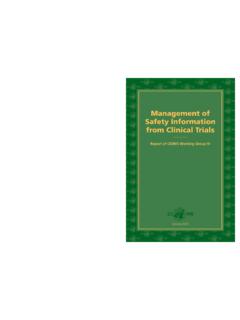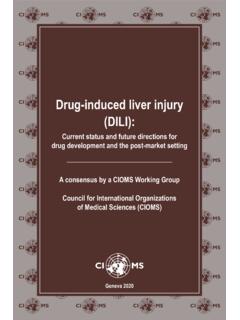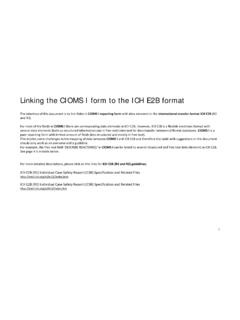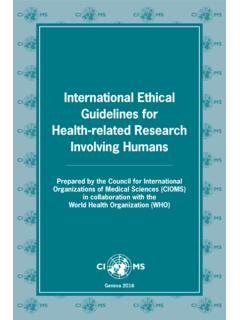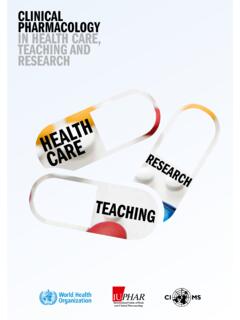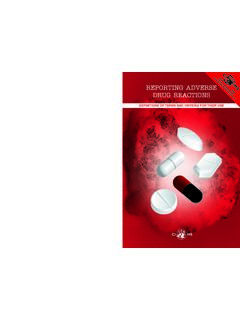Transcription of Practical Aspects of Signal Detection in Pharmacovigilance
1 Geneva 2010 CIOMS Practical Aspects of Signal Detection in Pharmacovigilance 2010 CIOMS publications may be obtained directly from CIOMS, c/o World Health Organization, Avenue Appia, 1211 Geneva 27, Switzerland or by e-mail to CIOMS and WHO publications are distributed by the World Health Organization, Marketing and Dissemination, Avenue Appia, 1211 Geneva 27, Switzerland and are available from booksellers through the network of WHO sales list of these agents may be obtained from WHO by writing to the above of SignalDetection inPharmacovigilanceReport of CIOMS Working Group 11 11:11 Practical Aspects OF Signal Detection IN PHARMACOVIGILANCER eport of CIOMS Working Group VIIIG eneva 11 11:12 Copyright 2010 by the Council for InternationalOrganizations of Medical Sciences (CIOMS)ISBN 92 9036 082 11 11:123 AcknowledgementsT he Council for International Organizations of Medical Sciences (CIOMS) gratefully acknowledges the contributions of the members of the CIOMS Working Group VIII on Practical Aspects of Signal Detection in Pharmacovigilance .
2 Moreover, CIOMS recognizes the generous support of the drug regulatory authorities, pharmaceutical companies and other organizations and institutions which provided their expertise and the resources that resulted in this publication. Each member participated actively in the discussions, drafting and redrafting of texts and their review, which enabled the Work-ing Group to bring the entire project to a successful thanks especially those members who chaired the meetings of the Work-ing Group VIII for their dedication and capable leadership. Each of the meetings had a nominated rapporteur and CIOMS acknowledges their professional editorial group, comprising Drs June Raine, Philippe Close, Gerald Dal Pan, Ralph Edwards, Bill Gregory, Manfred Hauben, Atsuko Shibata, June Almenoff, Lynn Macdonald and Stephen Klincewicz, merits special mention and thanks. CIOMS wishes to express special appreciation to Dr June Raine as Chief Editor of the fi nal contribution by the CIOMS/WHO Working Group on Vaccine Pharmacovigi-lance of the Points to Consider in Appendix 5 is gratefully and the Working Group are grateful for important input received on sev-eral points of the report from senior experts outside the Group who made valuable suggestions: Professor Stephen Evans, Dr Toshiharu Fujita, Dr David Madigan, Dr Niklas Nor n, Dr Hironori Sakai, Professor Saad Shakir, Dr Hugh Tilson and Dr Patrick , December 2009 Gottfried Kreutz, Juhana E.
3 Id np n-Heikkil ,Dr. med., MD, PhD, ProfessorSecretary-General, CIOMS Senior Adviser, 11 11 11 11:125 Table of Contents Preface .. 7I Introduction and scope of CIOMS VIII .. 9II Background Pharmacovigilance and key defi nitions .. 13 a. Need for Pharmacovigilance after regulatory 13 b. Defi nition of Pharmacovigilance .. 14 c. Defi nition and taxonomy of drug safety signals .. 14 d. Conclusions and recommendations .. 16 III Overview of approaches to Signal Detection .. 19 a. Traditional approaches .. 20 b. Emergence of statistical data mining 21 c. Conceptual framework for integrating traditional and statistical data mining methods .. 22 d. Interpretation of data mining results within an integrated approach .. 23 e.
4 Conclusions and recommendations .. 23IV Spontaneously reported drug safety-related information .. 25 a. Defi nitions of adverse event and reaction .. 25 b. data elements in a spontaneous reporting system .. 25 c. Mechanisms for reporting .. 27 d. Patient and consumer reporting .. 28 e. Limitations and challenges of spontaneous data .. 30 f. Reporting in special populations .. 32 g. Conclusions and recommendations .. 32V Databases that support Signal Detection .. 35 a. Spontaneous reporting databases .. 36 b. Other datasets that can be used for Signal Detection .. 37 c. data quality .. 39 d. Pharmacoepidemiology resources .. 39 e. Conclusions and recommendations .. 40VI Traditional methods of Signal Detection .
5 43 a. Case and case series review .. 43 b. Simple analyses of larger datasets .. 45 c. Conclusions and recommendations .. 47 VII More complex quantitative Signal Detection methods .. 49 a. History .. 49 b. Disproportionality analysis general concepts and caveats .. 49 c. Theory of disproportionality analysis .. 53 Basic methodologies and metrics .. 53 Bayesian methodologies .. 55 Frequentist versus Bayesian approaches .. 59 Evaluating data mining performance .. 59 d. Disclosure and review of potential confl ict of interest .. 62 e. Conclusions and recommendations .. 62 VIII How to develop a Signal Detection strategy .. 67 a. Stakeholder perspectives.
6 67 Expectations of consumers .. 67 Expectations of prescribers .. 68 Expectations of government regulators .. 68 Expectations for pharmaceutical companies (sponsors) .. 68 b. Regulatory considerations and international guidance .. 11 11:126 Pre-marketing Signal Detection .. 69 Post-marketing surveillance .. 70 c. Value added for integrating data mining methods into a Signal Detection program .. 70 d. Practical , technical and strategic points to consider .. 71 Selection of data types and sources .. 71 Attributes of the data .. 73 Attributes of drugs under monitoring .. 75 Attributes of patient populations under monitoring .. 76 Choosing specifi cations for a quantitative signalling approach.
7 76 e. Operational model and organizational infrastructure .. 79 Guiding principles .. 79 Design and implementation of data management systems .. 79 f. Quality assurance for the Signal Detection program .. 82 Guiding principles .. 82 Measures of effectiveness and effi ciency .. 82 Compliance .. 83 g. Conclusions and recommendations .. 84IX Overview of Signal management .. 87 a. Signal prioritization .. 88 Impact analysis .. 88 Further Signal prioritization .. 89 b. Signal evaluation.
8 89 Obtaining a consistent approach across all sources of safety 90 Assessing the strength of evidence from immediately available sources .. 90 c. Options analysis .. 93 Potential risk .. 93 Identifi ed risk .. 94 d. Reporting and communicating signals .. 95 e. Expectations for risk management planning .. 96 f. Conclusions and recommendations .. 97X Future directions in Signal Detection , evaluation and communication .. 101 a. Wider 101 b. New directions in data mining algorithms (DMAs) .. 101 Sensitivity and specifi city .. 101 Denominators .. 102 Screening for drug-drug interactions.
9 102 Confi rmatory data analysis .. 102 c. data mining in non-SRS datasets .. 103 Computerized longitudinal healthcare databases .. 103 Sequential monitoring .. 103 Cross-sectional screening or data mining .. 104 Continuous disproportionality screening .. 104 data mining, meta-analysis and clinical trial datasets .. 104 d. Use of ICSRs to evaluate impact of risk minimization .. 105 e. Communication of Signal information .. 105 Message content and delivery .. 105 Timing of Signal communication .. 106 f. Conclusions and recommendations .. 106 Appendices .. 109 1. Glossary and acronyms .. 109 2. Membership and working procedures of CIOMS Working Group VIII .. 119 3. International and national spontaneous reporting systems (SRS) databases.
10 121 4. Epidemiologic studies .. 137 5. Points to consider regarding differences between vaccines and drugs in Signal Detection .. 11 11:127 PrefaceIn recent years public expectations for rapid identifi cation and prompt manage-ment of emerging drug safety issues have grown swiftly. Over a similar timeframe, the move from paper-based adverse event reporting systems to electronic capture and rapid transmission of data has resulted in the accrual of substantial datasets capable of complex analysis and querying by industry, regulators and other public health two drivers have created a fertile environment for Pharmacovigilance sci-entists, information technologists and statistical experts, working together, to deliver novel approaches to detect signals from these extensive and quickly growing data -sets, and to manage them appropriately.
